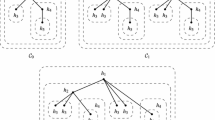Abstract
This paper presents a general framework for modelling with membrane systems that is based on a computational paradigm where rules have associated a finite set of attributes and a corresponding function. Attributes and functions are meant to provide those extra features that allow to define different strategies to run a P system. Such a strategy relying on a bounded parallelism is presented using an operational approach and applying it for a case study presenting the basic model of quorum sensing for Vibrio fischeri bacteria.
Preview
Unable to display preview. Download preview PDF.
Similar content being viewed by others
References
Bernardini, F., Gheorghe, M.: Population P Systems. J. UCS 10(5), 509–539 (2004)
Bianco, L., Fontana, F., Manca, V.: P Systems with Reaction Maps. International Journal of Foundations of Computer Science 17(1), 27–48 (2006)
Calder, M., Vyshemirsky, V., Gilbert, D., Orton, R.: Analysis of Signalling Pathways using Continuous Time Markov Chains. Transactions on Computational Systems Biology (to appear, 2006)
Cardelli, L., Philips, A.: A Correct Abstract Machine for the Stochastic Pi-calculus. Electronical Notes in Theoretical Computer Science (to appear, 2004)
Andrei, O., Ciobanu, G., Lucanu, D.: Structural Operational Semantics of P Systems. In: Freund, R., Păun, G., Rozenberg, G., Salomaa, A. (eds.) WMC 2005. LNCS, vol. 3850, pp. 31–48. Springer, Heidelberg (2006)
Collado-Vides, J.: Grammatical Models of the Regulation of Gene Expression. Proc. of National Academy of Science 89, 9405–9409 (1992)
Dang, Z., Ibarra, O.H., Li, C., Gaoyan, X.: Decidability of Model-Checking P Systems. Journal of Automata, Languages and Combinatorics (to appear, 2006)
Dang, Z., Ibarra, O.H.: On One-membrane P systems Operating in Sequential Mode. Int. J. Found. Comput. Sci. 16(5), 867–881 (2005)
Duan, Z., Holcombe, M., Bell, A.: A Logic for Biological System. Biosystems 53, 93–155 (2000)
Freund, R.: Asynchronous P Systems and P Systems Working in the Sequential Mode. In: Mauri, G., Păun, G., Jesús Pérez-Jímenez, M., Rozenberg, G., Salomaa, A. (eds.) WMC 2004. LNCS, vol. 3365, pp. 36–62. Springer, Heidelberg (2005)
Gillespie, D.T.: A General Method for Numerically Simulating the Stochastic Time Evolution of Coupled Chemical Reactions. J. Comput. Physics 22, 403–434 (1976)
Gillespie, D.T.: Exact Stochastic Simulation of Coupled Chemical Reactions. The Journal of Physical Chemistry 81(25), 2340–2361 (1977)
Hardie, K.R., Williams, P., Winzer, K.: Bacterial cell-to-cell communication: sorry, can’t talk now, gone to lunch. Current Opinion in Microbiology 5, 216–222 (2002)
Fargerströn, T., James, G., James, S., Kjelleberg, S., Nilsson, P.: Luminescence Control in the Marine Bacterium Vibrio fischeri: An Analysis of the Dynamics of lux Regulation. J. Mol. Biol. 296, 1127–1137 (2000)
Kam, N., Cohen, I.R., Harel, D.: The Immune System as a Reactive Systems: Modelling T Cell Activation with Statecharts, The Weizmann Institute of Science, Israel (2001)
Matsuno, H., Doi, A., Nagasaki, M., Miyano, S., Hybrid: Petri Net Representation of Gene Regulatory Network. In: Pacific Symposium on Biocompting, pp. 338–349. World Scientific, Singapore (2000)
Meng, T.C., Somani, S., Dhar, P.: Modelling and Simulation of Biological Systems with Stochasticity. Silico Biology 4(0024), 137–158 (2004)
Nealson, K.H., Hastings, J.W.: Bacterial Bioluminescence: Its Control and Ecological Significance. Microbiology Review 43, 496–518 (1979)
Păun, G.: Computing with Membranes. Journal of Computer and System Sciences 61(1), 108–143 (2000)
Păun, G.: Membrane Computing. An Introduction. Springer, Berlin (2002)
Jesús Pérez-Jímenez, M., Romero-Campero, F.J.: P Systems, a New Computational Modelling Tool for Systems Biology. In: Priami, C., Plotkin, G. (eds.) Transactions on Computational Systems Biology VI. LNCS (LNBI), vol. 4220, pp. 176–197. Springer, Heidelberg (2006)
Pescini, D., Besozzi, D., Mauri, G., Zandron, C.: Dynamical probabilistic P systems. International Journal of Foundations of Computer Science 17(1), 183–195 (2006)
Priami, C., Regev, A., Shapiro, E., Silverman, W.: Application of a Stochastic Name-Passing Calculus to Representation and Simulation of Molecular Processes. Information Processing Letters 80, 25–31 (2001)
Regev, A., Shapiro, E.: The π-calculus as an abstraction for biomolecular systems. In: Ciobanu, G., Rozenberg, G. (eds.) Modelling in Molecular Biology, pp. 219–266. Springer, Heidelberg (2004)
Segel, I.H.: Biochemical Calculations: How to Solve Mathematical Problems in General Biochemistry, 2nd edn. John Wiley and Sons, Chichester (1976)
Till, J.E., McCulloch, F., Siminovitch, L.: A Stochastic Model of Stem Cell Proliferation based on the Growth of Spleen Colony-Forming Cells. Proc. National Academy of Science USA 51, 117–128 (1964)
Walker, D., Holcombe, M., Southgate, J., McNeil, S., Smalwood, R.: The Epitheliome: Agent-Based Modelling of The Social Behaviour of Cells. Biosystems 76(1-3), 89–100 (2004)
Waters, C.M., Bassler, B.L.: Quorum Sensing: Cell-to-Cell Communication in Bacteria. Annu. Rev. Cell. Dev. Biol. 21, 319–346 (2005)
The P Systems: http://psystems.disco.unimib.it
Nottingham Quorum Sensing Web Site, http://www.nottingham.ac.uk/quorum/
Author information
Authors and Affiliations
Editor information
Editors and Affiliations
Rights and permissions
Copyright information
© 2006 Springer-Verlag Berlin Heidelberg
About this paper
Cite this paper
Bernardini, F., Romero-Campero, F.J., Gheorghe, M., Pérez-Jiménez, M.J. (2006). A Modeling Approach Based on P Systems with Bounded Parallelism. In: Hoogeboom, H.J., Păun, G., Rozenberg, G., Salomaa, A. (eds) Membrane Computing. WMC 2006. Lecture Notes in Computer Science, vol 4361. Springer, Berlin, Heidelberg. https://doi.org/10.1007/11963516_4
Download citation
DOI: https://doi.org/10.1007/11963516_4
Publisher Name: Springer, Berlin, Heidelberg
Print ISBN: 978-3-540-69088-7
Online ISBN: 978-3-540-69090-0
eBook Packages: Computer ScienceComputer Science (R0)




